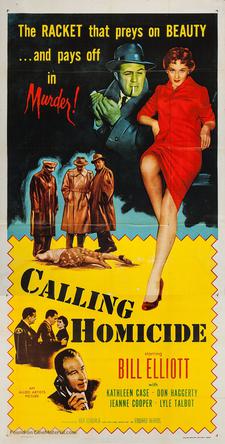Top Qs
Timeline
Chat
Perspective
Calling Homicide
1956 American film by Edward Bernds From Wikipedia, the free encyclopedia
Remove ads
Calling Homicide is a 1956 American crime drama film directed by Edward Bernds and starring Bill Elliott, Don Haggerty and Kathleen Case. The picture was the third of five films in the Lt. Andy Doyle series, all starring Elliott.[2]
Remove ads
Plot
When a policeman is murdered by a car bomb, Lt. Andy Doyle is given the case to investigate. On the victim he finds the name of a woman, Francine Norman, who is murdered shortly thereafter, strangled and mutilated. Doyle determines that there is a connection between the two deaths. Norman was a former actress who owned a modeling agency that is now run by Darlene Adams.
Doyle finds many suspects, as Norman was universally hated. He uncovers that the agency was being used as a front for a blackmailing racket most likely run by Norman's love interest Jim Haddix, the owner of a local construction company. However, all the evidence of the blackmail ring is destroyed when the modeling school is destroyed by fire, with the janitor as the main suspect.
Remove ads
Cast
- Bill Elliott as Lt. Andy Doyle
- Don Haggerty as Sgt. Mike Duncan
- Kathleen Case as Donna Graham
- Myron Healey as Jim Haddix
- Jeanne Cooper as Darlene Adams
- Thomas B. Henry as Alan Gilmore
- Lyle Talbot as Tony Fuller
- Almira Sessions as Ida Dunstetter
- Herb Vigran as Ray Engel
- James Best as Arnie Arnholf
- John Dennis as Benny Bendowski
- Robert Bice as Phipps
- John Close as Deputy Warren
- Mel Wells as Valensi
- Dee Carroll as Rita
- Stanley Adams as Peter Van Elda
- Mary Treen as Flo Burton
- Jack Mulhall as Pierson
- William Meigs as Ted Allen
- Harry Strang as Deputy Wall
Remove ads
See also
- Dial Red O (1955)
- Sudden Danger (1955)
- Chain of Evidence (1957)
- Footsteps in the Night (1957)
- List of American films of 1956
Production
The working title of the film was House on Lookout Mountain.[1] Production began in the first week of April 1956,[3][4] and was completed before the end of the month.[5][6] In July, the release date was announced as September 30, 1956.[7] The National Legion of Decency gave the film a Class A Section II rating, indicating that it was morally unobjectionable but for adults only.[8] In December, it was announced that Calling Homicide would be part of a two-film deal, along with Friendly Persuasion, booking first-run films directly into "second-run" theaters. It was the first such deal in the nation.[9]
Remove ads
Reception
Motion Picture Daily gave the film a good review, enjoying its action and pace. It complimented the complexity of the plot, the screenplay and Bernds' direction.[10]
References
External links
Wikiwand - on
Seamless Wikipedia browsing. On steroids.
Remove ads

